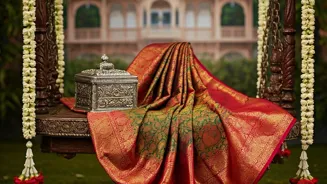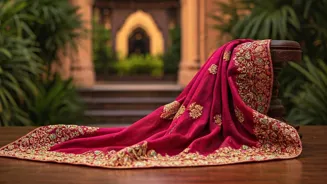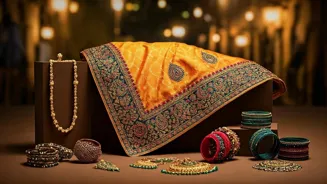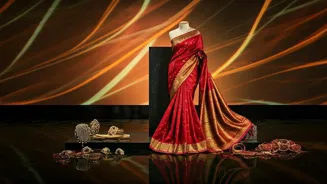Dive into the allure of traditional Indian jewelry with these 7 must-have pieces! From Jhumkas to Payals, each piece tells a story of culture and elegance. Explore the rich heritage and beauty of Indian adornments
Namaste, fashion enthusiasts! India, a land of vibrant colours, rich culture, and exquisite craftsmanship, boasts a jewelry tradition as old as time itself. More than just adornment, traditional Indian jewelry tells stories, symbolizes blessings, and reflects heritage.
If you are looking to add a touch of timeless elegance to your collection, or perhaps connect with your roots, these seven pieces are absolute must-haves! Get ready to be mesmerized by the sheer beauty and artistry.
Iconic Indian Jhumkas: Symbol of femininity, history, and versatility in jewelry fashion
First, we have the Jhumkas. These bell-shaped earrings are an iconic symbol of Indian femininity. The intricate designs, often featuring delicate carvings and hanging beads, create a mesmerizing swinging motion that catches the light with every turn of your head.
They are generally made up of gold and may also contain pearls, gemstones or enamel work. The history of Jhumkas dates back to ancient India, and they continue to be favored by women of all ages, both for daily wear and special occasions.
The best part is that a good pair of Jhumkas can elevate even the simplest of outfits, adding a touch of ethnic chic to your look. You can wear them with a simple Kurti or even pair it with a western dress. They are considered very auspicious since they are worn from the time of kings and queens.
A wedding or a function is deemed incomplete without the bride or other women participants doning a pair of beautiful jhumkas. Even these days, jhumkas have evolved with different designs, shapes and sizes to suit the needs of anyone.
Bangles symbolize prosperity and tradition in Indian culture
Next on the list are Bangles! A quintessential part of Indian dressing, bangles represent prosperity and good fortune. From delicate glass bangles to ornate gold ones, these circular adornments come in a dazzling array of materials, colors, and designs.
Traditionally, brides wear a multitude of bangles symbolizing a happy married life. Certain colors also hold specific significance. Red stands for energy and prosperity, green for fertility and good luck, and yellow for happiness.
Even a single bangle can add a pop of color and personality to your wrist. You could stack up a bunch of colorful glass bangles for a festive vibe, or opt for a single, intricately carved gold bangle statement piece. It would look beautiful on any hand if worn with love and pride.
In the earlier days the brides would fill up their wrists with bangles. However, modern day brides keep it short and classy with a limited number of them. Irrespective of how many you wear, bangles are a must to keep with you.
Maang Tikka: Cultural head ornament for elegance and tradition
The Maang Tikka comes next, and is a stunning head ornament worn on the forehead, the Maang Tikka holds immense cultural significance. It is believed to activate the 'ajna chakra', the centre of intuition and wisdom.
The design typically comprises a pendant suspended from a chain that is secured in the hair. Maang Tikkas are generally made of gold and decorated with kundan, pearls or gemstones. This is a very integral part of a bride's jewelry during a wedding ceremony.
Not just brides, but you can also wear a Maang tikka at other celebrations, festivals, ceremonies or events. It adds a regal touch to your overall look. You may want to pick a smaller version and not a very heavy one, as it can be cumbersome and make your head ache.
Select a piece that complements your face shape and attire for maximum impact. It will definitely enhance your natural beauty and bring out your inner grace. It has been a favorite jewelry amongst woman as it adds a charm and gives that extra dazzle.
Nose ring in India holds deep cultural significance and adds sensuality to one's look
Now comes the turn of the Nose Ring. This small but mighty piece of jewelry holds deep cultural and symbolic meaning in India. Also known as 'Nath', it is often associated with marriage and is considered an important part of a bride's solah shringar (sixteen adornments).
Nose rings come in a variety of designs, from simple studs to elaborate hoops adorned with stones and chains. Some communities have specific designs that are unique to their traditions.
Whether you choose a delicate diamond stud or a bold, ornate hoop, a nose ring adds a touch of sensuality and individuality to your look. It may be small, but don't underestimate its power to transform your appearance.
You can choose to wear a simple stud on your nose, because it is easy to wear and does not come in the way. On the other hand, if you are attending a wedding or a party, you can choose to wear the bigger one. These bigger ones are generally accompanied by a chain that is put behind the ear.
Bajuband: Regal armlet for elegant adornment in various designs and materials
Moving on, we have the Bajuband, an armlet worn on the upper arm, adds a touch of regal elegance to any outfit. Historically worn by both men and women, it is now more commonly associated with female adornment. Bajubands come in various materials, including gold, silver, and beaded designs.
They are best paired with sleeveless or short-sleeved outfits to show off their beauty. Wear it with a saree or a lehenga, it will accentuate your arms and add a touch of sophistication to your look. Its origins can be traced back to ancient India.
Usually they are made of gold with intricate carvings or embellishments. The designs can also vary from simple bands to elaborate pieces with hanging charms. Whether you like a sleek and minimalist design, or a bolder and more ornate piece, a Bajuband is sure to make heads turn.
It is best worn with traditional attire such as sarees, lehengas, or even a simple salwar kameez.
Payals: delicate anklets symbolizing femininity, grace, and cultural significance
Lastly, the Payal, also known as anklets, these delicate ornaments adorn the ankles and add a melodious jingling sound with every step. Payals are typically made of silver and can feature intricate designs, bells, and beaded embellishments.
This delicate piece of jewel is often associated with femininity and grace. You can choose from heavier, more elaborate designs for special occasions, or opt for a simple chain for everyday wear. Wear them with sandals, flats, or even barefoot, and let your ankles do the talking!
Not just that, Payals also have a cultural significance. It is believed that the sound of the bells attracts positive energy and wards off evil. Payals these days are not only limited to wearing on one ankle; they may be worn on both ankles.
Payal has been an ornament that has been loved by girls from time immemorial and will continue to be so.
AI Generated Content. Glance/InMobi shall have no liability for the content









